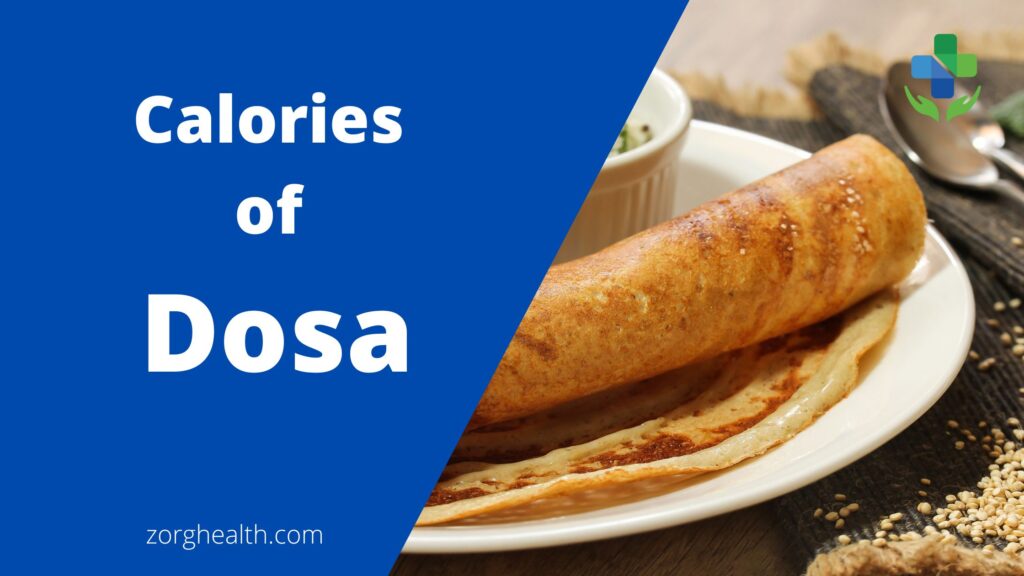Dosa ! or also called “dosey” “dosha” or “dosai” is a delightful cuisine from south India. Dosa is a type of thin, crispy crepe that is very popular in South Indian cuisine. The batter of Dosa is a type of fermented food, which means that it is made by adding a starter culture of bacteria and yeast to a mixture of ground rice and lentils.
The mixture is left to ferment for several hours or overnight, which helps to develop the flavor and texture of the dosa. Here are some more facts about dosa including the calories of dosa.

Calories of dosa – TOC
How is a dosa made?
Dosa is usually made by pouring a thin layer of fermented batter onto a hot griddle or tawa and spreading it out into a circular shape. The dosa is then cooked until it is crispy and golden brown, and it is typically served hot with a variety of accompaniments, such as chutney, sambar, or ghee.
In addition to being a popular breakfast food, dosa is also often served as a snack or as part of a larger meal. It can be enjoyed on its own or with a variety of accompaniments, such as chutney, sambar, or ghee.
How many varieties of dosa are there?
One of the great things about dosa is that it can be made with a variety of different ingredients and flavors, which means that there is a dosa for every taste and dietary preference. Some common variations of dosa include:
- Rava dosa: This type of dosa is made with semolina flour (also known as Rava or suji) instead of rice flour. It has a slightly coarser texture than a traditional dosa and is often served with a variety of chutneys or dips.
- Mysore masala dosa: This type of dosa is similar to regular masala dosa, but it is coated with a spicy red chutney made with red chilies and coconut before being filled with spiced potatoes.
- Onion dosa: As the name suggests, this type of dosa is filled with diced onions and is often served with a variety of chutneys or dips.
- Egg dosa: This type of dosa is made by cracking an egg onto the dosa while it is cooking and then folding it over. It is a popular street food in India and is often served with chutney or ketchup.
In addition to these variations, dosa can also be flavored with a variety of herbs and spices, such as cumin, coriander, and mustard seeds. It can also be served with a variety of accompaniments, such as chutney, sambar, or ghee, to add flavor and nutrition.
Calories of Dosa
The number of calories in a dosa can vary depending on the ingredients and the method of preparation. Here is a rough estimate of the calorie of dosa and its varieties:
- Plain dosa (made with rice flour and water): Approximately 100 calories per dosa
- Masala dosa (filled with spiced potatoes): Approximately 300-400 calories per dosa
- Rava dosa (made with semolina flour): Approximately 200 calories per dosa
- Onion dosa (filled with diced onions): Approximately 200 calories per dosa
It’s important to note that these estimates are rough and can vary depending on the specific recipe and serving size. If you are counting calories or trying to watch your intake, it’s a good idea to read the nutrition information on the label or ask for nutrition information at the restaurant.
There are many different variations of dosa, and the type of dosa you choose can have a significant impact on calorie content. For example, a plain dosa made with just rice flour and water is relatively low in calories, while a masala dosa filled with spiced potatoes is much higher in calories due to the added ingredients.
Why is dosa so popular?
In addition to being a delicious and flavorful food, dosa can also be a healthy choice. Some of the potential health benefits of dosa include:
- High in protein: Dosa is made with a mixture of ground rice and lentils, which means that it is a good source of protein. Protein is an important nutrient that helps to build and repair tissues in the body, and it is also necessary for the production of enzymes, hormones, and other molecules.
- Low in fat: Dosa is a relatively low-fat food, especially if it is made with just rice flour and water. This makes it a good choice for people who are trying to reduce their intake of saturated fat and cholesterol.
- High in complex carbs: Dosa is made with rice flour, which is a good source of complex carbohydrates. Complex carbs are slowly digested by the body and provide a sustained source of energy, which makes them a good choice for people who are looking to maintain a healthy weight or who need sustained energy throughout the day.
- High in fiber: Rice and lentils are both good sources of fiber, which is an important nutrient that helps to keep the digestive system healthy and regular.
What Is the best time to eat Dosa?
Although you can enjoy dosa at any time of day, Dosa is among the healthiest options for breakfast. Why is it considered best for breakfast-
- Dosa is very light for your digestive system: as it is a fermented food, it’s very beneficial for the gut and easily digested.
- Easy to make: for simple dosa, you just need to spread the better, no chopping or other tiring activities are needed.
- Contains healthy carbohydrates: Dosa comes with healthy carbohydrates and keeps you full for a longer duration.
- Contains very less FAT: for those who are having diabetes or heart problems, dosa high in saturated fat is a safe option for breakfast.
- Protein-rich source: especially for people who are on a vegetarian diet, dosa is a very good source of protein as it is made from lentils.
The Bottom Line
So, why wait? Include these above-mentioned varieties of dosa in your daily breakfast list without stressing about the calories of dosa. This easy-to-make recipe apart from satisfying your taste buds will also help in reducing weight.
